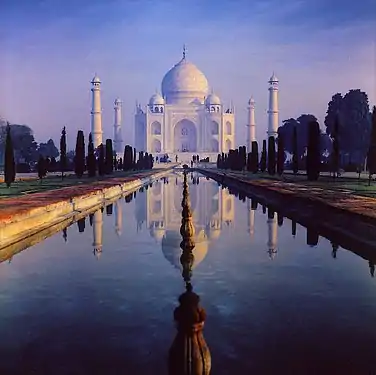Ruqʿah script
Ruqʿah (Arabic: رقعة), is a variety of the Arabic script, primarily used in official documents and every-day writing. Not to be confused with reqaʿ—one of the six traditional arabic scripts (al-aqlām al-sittah).
 |
| Part of a series on |
| Islamic culture |
|---|
| Architecture |
| Art |
| Clothing |
| Holidays |
| Literature |
| Music |
| Theatre |
|
Description and usage
Ruqʿah is the most common type of handwriting in the Arabic script. It is known for its clipped letters composed of short, straight lines and simple curves, as well as its straight and even lines of text. It was probably derived from the Thuluth and Naskh styles.
Unlike other types of calligraphy, ruqʿah is not considered as an art form. Instead, it is a functional style of writing that is quick to write and easy to read. Every literate Ottoman was expected to be able to use the ruqʿah.[1]
It was widely used in the Ottoman Empire.[2]
The demonstration underneath is not typical since it uses full vowels, which are rarely used in handwriting:
Gallery
.jpg.webp) Ruqʿah as a display typeface: A 1951 edition of the Young Egypt Party journal Al-Ishtirakiyya. Ruqʿah is used for the headlines, Naskh for body text.
Ruqʿah as a display typeface: A 1951 edition of the Young Egypt Party journal Al-Ishtirakiyya. Ruqʿah is used for the headlines, Naskh for body text. A letter hand written by Jurji Zaydan
A letter hand written by Jurji Zaydan Height of the letter Alif
Height of the letter Alif
Typefaces
Examples of a modern digital typeface rendering Arabic text in this style, are Aref Ruqaa by Abdullah Aref[3] and B Arabic Style by Borna Rayaneh.[4]
References
- M. Uğur Derman, Letters in Gold: Ottoman Calligraphy from the Sakıp Sabancı Collection, Istanbul, New York, Metropolitan Museum of Art, 1998, p.20
- "Creative Arabic Calligraphy for Beginners: Introduction". EnvatoTuts. 2014-11-10. Retrieved 2017-05-04.
- https://github.com/alif-type/aref-ruqaa
- https://fonts2u.com/b-arabic-style.font
